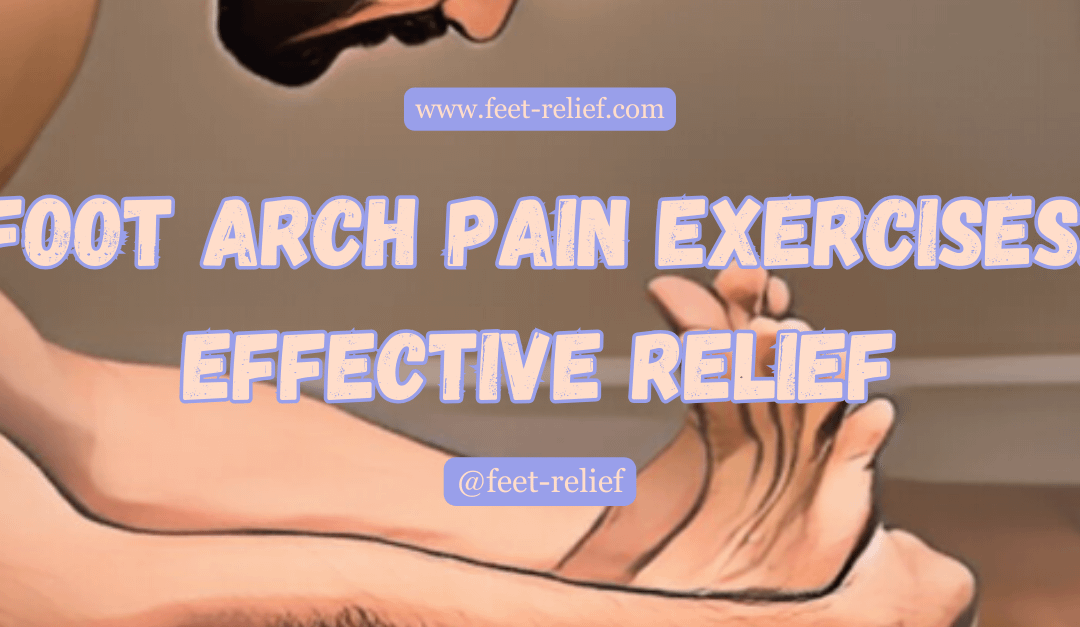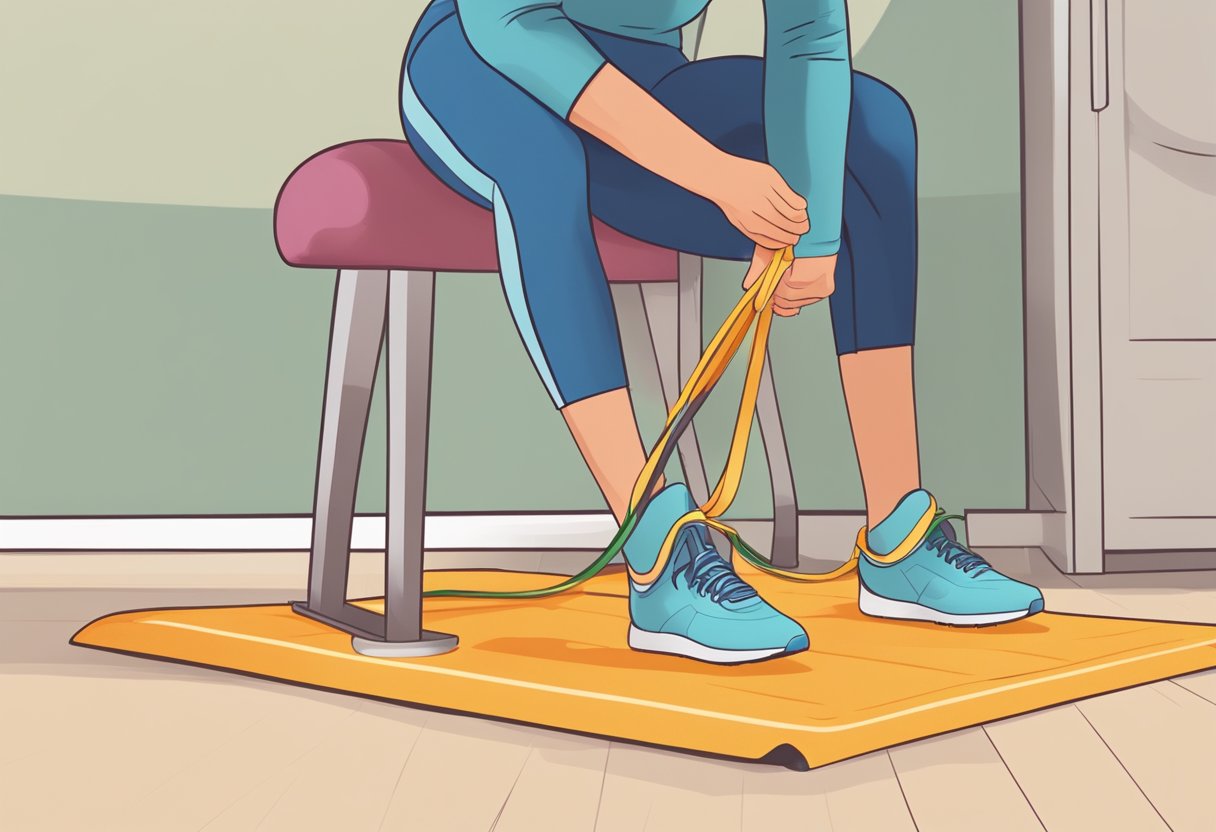Feet-Relief is supported by our audience. When you purchase through one of our links, we may earn a small affiliate commission. As an Amazon Associate I earn from qualifying purchases.Your cost is not affected.
Experiencing pain in the arch of your foot can be a barrier to daily activities, but incorporating some targeted exercises might bring relief. The arch is vital for balance and walking, and strain in this area can be due to various factors, including overuse, insufficient support, or certain foot conditions. Assuaging this discomfort often involves exercises designed to strengthen and stretch the muscles and ligaments that support the arches of your feet.
Foot Arch Pain Exercises: Effective Relief Strategies for Sore Feet
Performing exercises like arch lifts and plantar fascia stretches can improve the stability and flexibility of your feet. For example, arch lifts focus on raising the arch while keeping your heel and toes grounded, which can be done either seated or standing.
Similarly, a stretch for the plantar fascia may require you to gently pull your toes toward you or roll a ball under the arch of your foot for a soothing massage. Consistency is key for these exercises to be effective, and they can be easily integrated into your daily routine.
Key Takeaways
- Targeted exercises can help alleviate arch pain.
- Arch lifts and plantar fascia stretches are beneficial.
- Consistency with exercises can improve foot health.
Understanding Foot Arch Pain
Video Credit: @barefootrehab
Foot arch pain can be limiting, affecting your daily activities and overall mobility. This section provides detailed insights into the foot arch’s anatomy, explores potential causes of pain, and discusses the symptoms you may experience and how the condition is diagnosed.
Anatomy of the Foot Arch
Your foot arch is a complex structure composed of bones, ligaments, and tendons that support your body’s weight. The main arch is known as the medial longitudinal arch, and there are two other arches: the lateral longitudinal arch and the anterior transverse arch.
Causes of Foot Arch Pain
The most common causes of foot arch pain include overuse, structural imbalances, improper footwear, or acute injury. Conditions such as plantar fasciitis and flat feet can also lead to discomfort in this area.
Symptoms and Diagnosis
If you’re experiencing a sharp, stabbing pain in the arch of your foot, particularly during the first steps in the morning, you may have plantar fasciitis. Other symptoms can include swelling and increased pain after prolonged activity. Diagnosis usually involves a physical examination and, in some cases, imaging tests like an X-ray or MRI to rule out fractures or other abnormalities.
Exercises for Foot Arch Pain
Video Credit: @ImpactCareTherapy
Incorporating specific exercises can significantly alleviate foot arch pain by improving strength, flexibility, and balance. Focus on these tailored movements to target your foot concerns.
Stretching Exercises
- Toe Pulls: To help with arch pain, firmly pull your toes back towards you, holding the stretch to feel tension along the bottom of your foot. This stretch can increase flexibility and reduce tightness.
- Calf Stretches: Stand facing a wall with one foot behind the other and gently lean forward, keeping your back heel on the ground. Hold this position to stretch the calf muscle linked to your arch’s support structure.
Strengthening Exercises
- Marble Pickups: Strengthen the intrinsic muscles by picking up marbles with your toes and placing them into a bowl. The Cleveland Clinic suggests using this exercise to improve the structural integrity of your foot.
- Towel Scrunches: Place a towel flat on the ground and use your toes to scrunch it towards you, which can strengthen the arch muscles by mimicking the contraction needed to maintain a proper arch.
Balance and Mobility Exercises
- Heel Raises: Stand on your toes on the edge of a step and slowly lower your heels down below the step level. Heel raises promote balance and strengthen the muscles around your arch and calf.
- Single-leg Balancing: Stand on one foot, attempting to balance for thirty seconds to one minute. This exercise challenges your balance and activates the muscles supporting your foot arch.
Treatment and Management
Video Credit: @FootScientificStore
Effective management of arch pain is pivotal in resuming your daily activities without discomfort. The following strategies and recommendations are aimed to reduce your symptoms and support the healing process.
Conservative Treatments
To begin treating your foot arch pain, start with rest and reduce activities that exacerbate the pain. Incorporate gentle stretching exercises that can alleviate tension in the plantar fascia.
Arch pain exercises, such as towel curls and calf stretches, can be especially beneficial. Also, consider using ice therapy to reduce inflammation after activities.
Supportive Footwear Recommendations
Wearing the right shoes is vital. Opt for shoes that provide ample arch support and cushioning to minimize stress on the feet.
Over-the-counter orthotic inserts can also significantly improve comfort. For specific recommendations, footwear advice from health professionals can guide you in making the best choice for your needs.
When to See a Specialist
If your pain persists or worsens despite conservative measures, consult a healthcare specialist such as a podiatrist. Severe cases may require more advanced treatments, such as physical therapy, custom orthotics, or even surgery. Plantar fasciitis interventions may be necessary for pain not alleviated by stretches.
Prevention of Foot Arch Pain
Video Credit: @drkristieennis
Proper prevention strategies can greatly reduce your chance of experiencing foot arch pain. Focus on footwear, lifestyle, and weight management to maintain healthy arches.
Proper Footwear Selection
Selecting the right footwear is crucial for preventing arch pain. Shoes should provide proper support to the longitudinal arch and have sufficient cushioning.
Look for a well-fitted shoe with a firm midsole and adequate arch support. Avoid high heels and shoes with flat soles that do not offer enough cushioning.
Lifestyle Modifications
Incorporating foot exercises and stretches into your daily routine can strengthen the foot muscles, therefore supporting the arches. Consider exercises aimed at strengthening the Achilles tendon and calf muscles, as these can also benefit the arches by providing better support. Maintain an active lifestyle, but remember to rest your feet if you start feeling discomfort.
Weight Management
Maintaining a healthy weight minimizes the stress on your foot arches. Excess weight can place undue strain on your feet, leading to arch pain. Adopt a balanced diet and engage in regular physical activity tailored to your fitness level, which will indirectly contribute to the health of your feet.
Wrapping It Up
Exercise can effectively relieve foot arch pain. Try stretches and strengthening routines regularly. Wear supportive shoes and rest when needed.
If pain persists, consult a healthcare professional. Remember, consistent exercise can reduce discomfort and improve foot health. Keep your feet strong and pain-free!
Frequently Asked Questions
What exercises can help relieve pain in the foot’s arch?
For general arch pain relief, toe curls and towel grabs are effective in strengthening the intrinsic muscles of the foot. Arch Pain: Exercises | Kaiser Permanente outlines specific movements, such as pulling the toes back to feel a stretch beneath the foot.
Which specific physiotherapy exercises are recommended for alleviating pain in the arch of the foot?
Heel raises and arch lifts are recommended to build strength and stability in the arch of the foot. These exercises can be particularly beneficial if you’re experiencing arch pain due to conditions like plantar fasciitis.
What are appropriate foot exercises for seniors experiencing arch discomfort?
Seniors can benefit from low-impact exercises such as seated heel raises and toe spreaders. These gentle movements support arch health without putting undue stress on the feet.
How can one perform physical therapy exercises to address pain in the foot?
Consistency is key when performing physical therapy exercises for foot pain. Start with exercises like rolling a ball under the foot for a gentle massage or picking up marbles with toes to improve mobility and relieve discomfort.
What are effective methods to stretch and loosen tight muscles in the foot?
To stretch and loosen tight muscles in the foot, use a stretch strap or towel to pull back on the toes while lying down gently. This allows for a focused stretch in the arch area. Balancing exercises can also help in improving muscle tightness by promoting strength.
Are there exercises that target the inner foot arch, particularly for conditions other than plantar fasciitis?
Yes, exercises like doming, where you attempt to “shorten” the foot without curling the toes and walking on the insides of the feet, can specifically target the inner foot arch, aiding in strengthening the area and alleviating the associated pain.
Learn What’s Best for Your Feet!
Learn what’s best for your feet with us! We offer an array of tips and tricks for foot care and relief.
For a deeper dive into foot health, visit our website: feet-relief.com.
Your journey towards happy, healthy feet starts here!
Amazon and the Amazon logo are trademarks of Amazon.com, Inc, or its affiliates.



